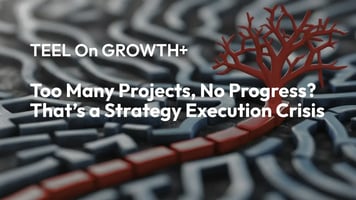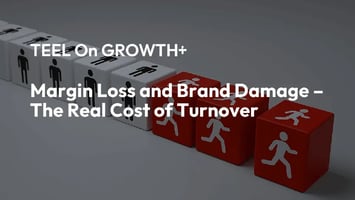Why revenue tanks when leadership loses focus—and how to get back on track Executive Briefing When...
Why Founder-Led Sales Models Always Hit a Ceiling
Why rainmakers stall-and how to build a sales engine that scales without you
Executive Briefing
Founder-led sales is a double-edged sword. In the early years, a founder’s energy, insight, and relationships fuel rapid customer wins. But that same strength soon becomes the company’s growth ceiling. Deals depend on the founder’s presence, the team defers to executive involvement, and the brand itself shrinks to one person.
The warning signs are predictable: clients insist on founder participation, sales processes are inconsistent, CRM tools gather dust, and forecasts collapse into optimism. Without defined deal stages, qualification standards, or reliable metrics, growth becomes reactive—wins and losses both come as surprises.
The fix is not more hustle; it is architecture. Companies that break through this ceiling build what we call Sales Engine Architecture:
- Document the founder’s method so intuition becomes instruction.
- Hire true sales leadership with ownership of pipeline, cadence, and accountability.
- Build playbooks and enforce process discipline across deal stages and CRM.
- Install leading metrics, not just lagging ones, to drive visibility and control.
- Redefine the founder’s role as amplifier—focusing on strategic accounts and market evangelism rather than day-to-day selling.
Yet stepping back from daily selling does not mean stepping away from sales. The most effective CEOs remain closely connected to the pipeline and treat revenue discipline as a permanent executive responsibility.
The strategic insight is clear: sales cannot remain an art form performed by a rainmaker. It must evolve into infrastructure—repeatable, measurable, and transferable. Companies that make the shift gain cleaner forecasts, higher valuations, and stronger investor confidence, while freeing the founder to focus on strategy and talent.
Every founder reaches this inflection point. The test of executive effectiveness is not closing the next deal, but building the engine that ensures growth long after the founder leaves the room.
THE FOUNDER WAS RACING THROUGH an airport terminal, phone pressed to his ear, laptop bag sliding off his shoulder. A customer needed him on the contract call. The team had prepped for weeks, but the client wouldn’t sign until the founder joined. By the time he reached the gate, the deal was saved—at the cost of another weekend hijacked by sales.
This is the trap of founder-led sales. Energy and relationships drive early growth, but personality does not scale. Sales scales through process, leadership, and infrastructure.
The Limits of Founder-Led Sales
Most young companies win their first customers through the founder. A sharp pitch, insider knowledge, and personal urgency create momentum. The founder is the rainmaker—credible, persuasive, relentless.
That approach works in year one. It can even carry the company to its first $5M or $10M in revenue. But the model has a built-in flaw: it has no repeatability. Every deal depends on one person. What feels like strength in the early stage becomes fragility when scale requires consistency.
If sales performance rises and falls with the founder’s calendar, growth will stall.
The Bottleneck Becomes the Brand
Clients come to expect the founder. They want the visionary at the table, not a junior sales rep. Every late-stage negotiation circles back to, “Will the CEO attend?”
Inside the company, the problem compounds. The team hesitates to sell without executive involvement. Proposals wait for founder edits. Sales calls linger until the CEO is free. The culture signals that nothing counts unless the founder blesses it.
Externally, the optics are worse. When clients only see the founder, they conclude two things: the company is small, and the founder is indispensable. That weakens confidence in delivery capacity and increases pressure on the founder to be present everywhere at once.
The result: the founder’s availability sets the growth ceiling. Time—not market demand—becomes the constraint.
When Sales Has No Structure
Beyond dependence on one leader, most founder-led sales models lack process discipline. The telltale signs are familiar:
- No defined deal stages or milestones.
- Inconsistent qualification criteria.
- CRM data used as an afterthought, not as a decision tool.
- Forecasts based on optimism rather than evidence.
Without structure, every opportunity feels urgent and every forecast feels thin. The board sees volatility. The team feels confused. And competitors with disciplined sales machines march ahead.
No Leadership, No Metrics
The weakness is not only process. It is also leadership. In many mid-market companies, business development roles are ill-defined and under-supported. Salespeople chase leads without clear ownership or accountability.
Data is anecdotal—living in heads and email threads rather than systems and dashboards. Metrics, if they exist, focus on lagging indicators such as closed/won deals, rather than leading measures such as booked meetings, opportunities advanced, or pipeline health.
When leadership and metrics are missing, sales execution becomes reactive. Wins surprise. Losses surprise. Growth becomes a gamble.
At this point, hustle won’t break the ceiling. Architecture will.

Sales Engine Architecture
Breaking through requires a deliberate shift—from rainmaker to sales engine. That shift follows five structural moves:
- Document the Founder’s Method
Every founder has a personal sales rhythm: how they open doors, frame the value proposition, and handle objections. Codify it. Write it down. Capture the language, the pacing, the proof points. What was once intuition must become instruction that builds a sales team. - Hire Sales Leadership with Ownership
Do not delegate sales as an “extra” responsibility. Appoint a leader who owns the number, sets expectations, and runs the cadence. The role is not administrative—it is accountable for pipeline, performance, sales enablement, and people. - Build Playbooks and Process Discipline
Codify deal stages. Define qualification criteria. Require CRM usage that mirrors the process, not as compliance but as the system of record. When sales reviews focus on deal stage movement, not opinions, execution accelerates. - Install Metrics That Lead, Not Lag
Move beyond sales booked. Track weekly activity, opportunity creation, and stage advancement. Build dashboards that show where deals live, where they’re stuck, and what drives progress. Visibility drives accountability. - Redefine the Founder’s Role
The founder should not vanish from sales. Instead, reposition them where they add unique value—strategic accounts or big deals, relationship support, market evangelism. They move from deal lead to deal amplifier.
This is the architecture that unlocks scale.
Strategic Insight
The insight is simple but hard: founder-led sales feels powerful because it works—until it doesn’t. The very intensity that wins the first clients becomes the bottleneck that stops the next stage.
Companies that scale understand sales is not an art form performed by one rainmaker. It is infrastructure—repeatable, measurable, and transferable. The founder’s passion can still ignite growth, but the engine must be built on process, leadership, and discipline.
The payoff is not abstract. Companies that make this shift see cleaner forecasts, higher valuations, and greater investor confidence. More importantly, they free the founder’s calendar to focus on strategy, talent, and partnerships. What once limited scale becomes the platform for it.
The Decisive Close
Every founder faces the same inflection point: remain the rainmaker, or build the sales engine. The first choice limits growth to personal capacity. The second creates a business that scales beyond its founder.
Sales leadership is not delegation. It is the ultimate test of executive effectiveness.
Scaling requires the founder to step out of day-to-day selling — but never out of sales. The most effective CEOs remain tightly connected to the pipeline and make sales discipline a permanent executive responsibility.
Because companies don’t stall for lack of opportunity. They stall because the founder never let sales grow up.
References
The insights in this article are drawn from the author’s direct observations, data analysis, and strategic findings across client engagements at Teel+Co, as well as his prior corporate experience as a senior financial leader in mid-market companies.
Copyright © 2025, Charles W. Teel Jr., CPA, LLC. All Rights Reserved.




